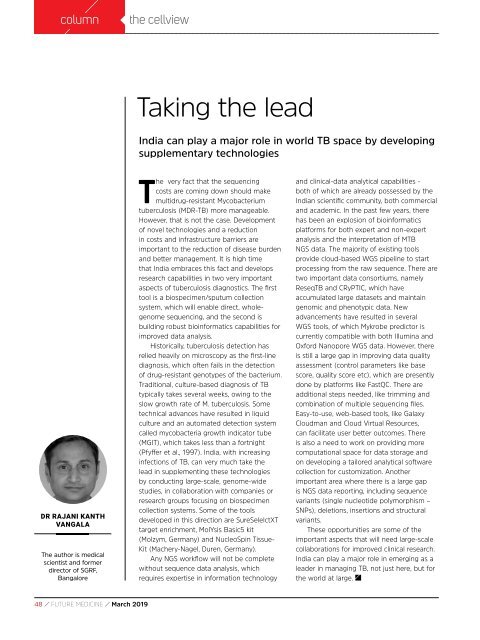March 2019 digital v1
Create successful ePaper yourself
Turn your PDF publications into a flip-book with our unique Google optimized e-Paper software.
column<br />
the cellview<br />
Taking the lead<br />
India can play a major role in world TB space by developing<br />
supplementary technologies<br />
DR RAJANI KANTH<br />
VANGALA<br />
The author is medical<br />
scientist and former<br />
director of SGRF,<br />
Bangalore<br />
The very fact that the sequencing<br />
costs are coming down should make<br />
multidrug-resistant Mycobacterium<br />
tuberculosis (MDR-TB) more manageable.<br />
However, that is not the case. Development<br />
of novel technologies and a reduction<br />
in costs and infrastructure barriers are<br />
important to the reduction of disease burden<br />
and better management. It is high time<br />
that India embraces this fact and develops<br />
research capabilities in two very important<br />
aspects of tuberculosis diagnostics. The first<br />
tool is a biospecimen/sputum collection<br />
system, which will enable direct, wholegenome<br />
sequencing, and the second is<br />
building robust bioinformatics capabilities for<br />
improved data analysis.<br />
Historically, tuberculosis detection has<br />
relied heavily on microscopy as the first-line<br />
diagnosis, which often fails in the detection<br />
of drug-resistant genotypes of the bacterium.<br />
Traditional, culture-based diagnosis of TB<br />
typically takes several weeks, owing to the<br />
slow growth rate of M. tuberculosis. Some<br />
technical advances have resulted in liquid<br />
culture and an automated detection system<br />
called mycobacteria growth indicator tube<br />
(MGIT), which takes less than a fortnight<br />
(Pfyffer et al., 1997). India, with increasing<br />
infections of TB, can very much take the<br />
lead in supplementing these technologies<br />
by conducting large-scale, genome-wide<br />
studies, in collaboration with companies or<br />
research groups focusing on biospecimen<br />
collection systems. Some of the tools<br />
developed in this direction are SureSelelctXT<br />
target enrichment, MolYsis Basic5 kit<br />
(Molzym, Germany) and NucleoSpin Tissue-<br />
Kit (Machery-Nagel, Duren, Germany).<br />
Any NGS workflow will not be complete<br />
without sequence data analysis, which<br />
requires expertise in information technology<br />
and clinical-data analytical capabilities -<br />
both of which are already possessed by the<br />
Indian scientific community, both commercial<br />
and academic. In the past few years, there<br />
has been an explosion of bioinformatics<br />
platforms for both expert and non-expert<br />
analysis and the interpretation of MTB<br />
NGS data. The majority of existing tools<br />
provide cloud-based WGS pipeline to start<br />
processing from the raw sequence. There are<br />
two important data consortiums, namely<br />
ReseqTB and CRyPTIC, which have<br />
accumulated large datasets and maintain<br />
genomic and phenotypic data. New<br />
advancements have resulted in several<br />
WGS tools, of which Mykrobe predictor is<br />
currently compatible with both Illumina and<br />
Oxford Nanopore WGS data. However, there<br />
is still a large gap in improving data quality<br />
assessment (control parameters like base<br />
score, quality score etc), which are presently<br />
done by platforms like FastQC. There are<br />
additional steps needed, like trimming and<br />
combination of multiple sequencing files.<br />
Easy-to-use, web-based tools, like Galaxy<br />
Cloudman and Cloud Virtual Resources,<br />
can facilitate user better outcomes. There<br />
is also a need to work on providing more<br />
computational space for data storage and<br />
on developing a tailored analytical software<br />
collection for customization. Another<br />
important area where there is a large gap<br />
is NGS data reporting, including sequence<br />
variants (single nucleotide polymorphism –<br />
SNPs), deletions, insertions and structural<br />
variants.<br />
These opportunities are some of the<br />
important aspects that will need large-scale<br />
collaborations for improved clinical research.<br />
India can play a major role in emerging as a<br />
leader in managing TB, not just here, but for<br />
the world at large.<br />
48 / FUTURE MEDICINE / <strong>March</strong> <strong>2019</strong>


















